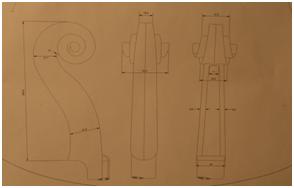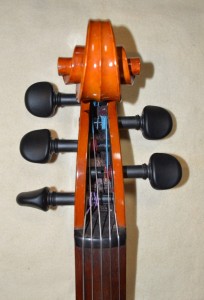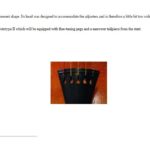- 2014-3-31
- GLOSSARY, MEETING [3] / Further Adjustments and Tests (Pegs etc.)
- copal, dragon's blood, elemy, mastic, shellac
| (Words printed in Italic are explained in further detail within this glossary.) | |
| adjusters |
the small screws on the tailpiece that are used for fine- tuning a string instrument |
| bariolage |
a technique that involves the use of an open string for an accompaniment which separates itself from the melodic progression on another string; (See also suite BVW 1007; Prélude; M.33 and following.);it is crucial that the separate notes are played on the different, open string; otherwise the melody cannot be properly recognized |
| bass bar |
a wooden beam glued roughly parallel to the strings onto the underside of the belly of a string instrument; its main function is, like the sound post‘s function, to withstand the pressure from the strings; with the introduction of longer necks, steel strings and higher pitches the bass bar gradually became taller and longer |
| belly |
the top or lid of a string instrument |
| bridge |
one of the two places of a string instrument where the strings‘ vibration is stopped down by touching a part of the instrument (the other one being the nut); it is positioned between the f-holes and transmits the vibrations of the strings to the belly and through the sound post to the bottom; see pictures 7, 11; there are two basic types of bridges: Belgian and French; Belgian bridges have long legs, a slight body and produce a strong and bright sound color; French bridges have shorter legs, a bigger body and produce a gentler and warmer sound color |
| bouts/ribs |
the side walls of a string instrument |
| button |
the top part of the back of a string instrument; it is a rather important part of the instrument: since the neck is glued on there a considerable amount of pressure has to be accounted for Button of a cello. Click on picture to enlarge. |
| c-bouts |
the c-shaped and mirror c-shaped narrowing of the body in the middle of a string instrument; the c-bouts are necessary to allow the bow access to the outer (C and a) strings; a further reason for the necessity of the c-bouts is the strong pressure on the belly in that area, the body has to be narrower there in order to deal with that pressure A cello’s c-bout. |
| copal |
a type of resin, mostly of fossil origin |
| dragon’s blood |
a type of resin with a bright red color,; it is gained from various tree-like plants and is used mainly for color effects |
| elemi |
a type of resin, usually coming from India, Brazil or Cameroon |
| endpin |
the endpin is an extractable rod at the bottom of the cello; without it the player would have to clamp the instrument between the knees; endpins are manufactured in various types and materials but tests have shown that a cello produces the biggest sound when equipped with the massive steel type |
| fingerboard | a wooden (usually ebony) plate glued to the neck; on the fingerboard the player’s fingers stop the strings down in order to produce various pitches |
| f-holes | the f-holes are the two f-shaped openings on the belly of a string instrument; the bridge transmits the strings’ vibrations to the belly and the sound post transmits them to the bottom; the collected vibrations in the vessel are then reflected through the f-holes to the outside and reach the listener’s ear; the shape was chosen rather for acoustic than decorative reasons |
| mastic | a plant resin, also called Arabic gum; it is used for the varnish of a string instrument |
| nut | one of the two places of a string instrument where the string’s vibration is stopped down by touching a part of the instrument (the other being the bridge); the nut is located just below the pegbox; the distance from bridge to nut determines the string length; string length of a 4/4 cello is ideally between 680 and 690 mm |
| pegbox | the upper part of a string instrument containing the pegs that allow a rough tuning of the cello’s strings, the fine-tuning is done with the adjusters on the tailpiece; the lowest part of the pegbox is just above the nut; the highest part is the scroll
The pegbox of a cello. |
| pegs |
plucks, usually made of wood, holding the strings on the opposite side of the tailpiece; they are put into the pegbox and can be turned to change the pitch
|
| purfling |
an inlaid strip with black edges, placed on the outer brim of the belly and back of a string instrument; purfling serves not only esthetical purposes but also is supposed to stop potential cracks proceeding along the graining lines of the wood |
| resin | a sticky substance, usually secreted from trees; it is used for the varnish of a string instrument; in its hardened form it is applied to the bow hairs in order to produce the necessary friction with the string |
| ribs/bouts | the side walls of a string instrument |
| scroll | the upper part of the pegbox; its acoustical influence on an instrument’s sound is disputet, the esthetical influence is not: the beauty of the scroll is another ‘calling-card’ of a violin maker |
| shellac | a type of resin consisting of the secretions of the lac bug |
| sound post | a round stick, positioned inside the instrument slightly in front of the left foot of the bridge; it helps to withstand the pressure from the bridge and also transports the vibrations from strings and bridge to the bottom |
| sticklac | a type of resin produced by an Asian shield louse |
| Stradivari | Antonio Stradivari (1644-1737); Italian violin maker; pupil of Niccolò Amati; Stradivari’s instruments are supposed to have perfect proportions and sound properties and therefore served as models for violin makers until the present time |
| strings | the strings of a cello were originally made of catgut; nowadays most cellists use steel-wound strings with a synthetic core; the two low strings arer often tungsten-wound because tungsten is a very strong metal that allows for making the strings quite thin; a thin string is more easily to be handled with both left and right hand |
| tailpiece | a piece of wood, metal or plastic that is fixed between the endpin socket and the lower ends of the strings; usually it is equipped with adjusters |
| varnish | the transparent lacquer of a string instrument; it consists of various components such as resin, oil, glue and color |
| violin dealer | a person who sells string instruments but is not necessarily able to manufacture or to repair them |
| violin maker | (also called a luthier) a person who can manufacture and repair any string instrument, not only violins; not to be mistaken with a violin dealer a violin maker might sell instruments and instrument-related items but his priority is the conservation of existing instruments and the creation of his own; repairing and building string instruments requires a very high level of craftsmanship and knowledge in many different disciplines |
| wolf | a disturbance of a string’s vibration on certain pitches, caused by acoustical interferences between the vibrations of strings’ and the instrument’s body, producing the so-called wolf-tone; on a four-string cello it is usually most strongly present within the G-string’s forth position, affecting pitches from e to g; there are several devices (‘wolf killers’) that can suppress a wolf tone to some degree (The Ngeringa cello in picture 25 has a wolf killer attached to its G-string.) |





